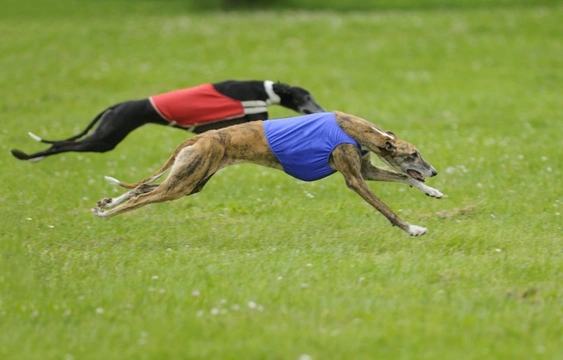
Lure coursing for sighthounds
Sighthounds are dogs that hunt by sight rather than by scent, and historically, sighthounds were highly valued for their skills as hunters, both to catch food for themselves and their handlers, and to help to keep the population of destructive wildlife such as rats and rabbits under control.
Later, certain sighthound breeds such as the greyhound became valued for their skills on the racetrack, being more widely used for canine sport than for hunting. Even today, when the vast majority of sighthounds are kept as pets, the instinctive desire to hunt remains strong within dogs of this type, which can make keeping wildlife and smaller pets such as cats safe when outdoors challenging.
However, as well as training your dog for good recall and not to chase things without permission, another way to help to manage your sighthound’s hunting instincts is to channel it into a canine sport, such as lure coursing. We will look at this in more detail within this article.
Sighthounds and hunting
A huge number of breeds fall within the sighthound heading, including the greyhound, the Saluki and the whippet. Dogs that are of mixed breeding with a sighthound ancestor are also referred to as sighthounds, such as the ever-popular Lurcher.
While there are a huge number of sighthound breeds in the world, they all tend to share a range of common traits: They are tall and lean in relation to their height, and they have a very high running speed! They also hunt by sight rather than smell, and they are much better at spotting a moving target than a stationary one, and so will be much more likely to take off after prey that is on the move than something that is sitting still.
What is lure coursing?
Lure coursing is an artificial form of hare coursing, in much the same way that drag hunting is an artificial form of fox hunting. Both sports simulate the chase and kill, tapping into the dog’s instinctive pursuit instincts, but without posing the associated risk to wildlife.
The “lure” used for lure coursing can vary, but may be as simple as a bundle of rags tied in a ball and pulled along by a rope!
Lure coursing can be undertaken casually at home for fun, within organised groups and clubs, or in teams and in competition, depending on the area that you live in and what you hope to achieve.
Lure coursing courses
Lure coursing clubs and organisations arrange regular meets for fun, training and sometimes, competition. Within these clubs and meets, lure coursing tends to follow a fairly set formula.
A course of between 100-1,000 yards is constructed following a pattern that is intended to simulate live hare coursing, and may or may not incorporate the use of jumps, other obstacles, and twists and turns to simulate the natural behaviour of prey when trying to throw a dog off the chase.
Lure coursing courses are generally constructed within enclosed areas to prevent the opportunity of one of the dogs running off, but as sighthounds are very single minded when it comes to hunting, once they are engaged in and committed to the chase, they are unlikely to veer off their course and try to make a break for it!
Can my dog have a go?
In order to have a go at lure coursing, your dog should be at least one year old, as lure coursing is a high-impact sport that can potentially cause damage to the growing joints of younger dogs. For organised competitions, in some cases, only pedigree sighthounds are eligible to compete, but in most cases, any dog of a sighthound breed or type is invited to have a go.
In some clubs and organisations, dogs of any breed, not just sighthounds are able to get involved in lure coursing, particularly if they display the necessary instincts for the sport, and can keep up with the competition!
How to get involved
Lure coursing as a sport is more popular within the USA than it currently is in the UK, but nevertheless, the sport has a keen and enthusiastic following here too, and even a national governing body, the British Sighthound Field Association.
The rules of lure coursing ensure that no live game is ever used within the sport, and the organisation is endorsed by various breed clubs that support responsible dog ownership, which includes taking steps to keep wildlife safe from hunting dogs.
In order to get involved in lure coursing with the British Sighthound Field Association, your dog must be of a sighthound breed, and you can attend a trialling meeting which will give your dog an opportunity to have a go at following the lure and see how they get on with things. Events are held regularly throughout the year, and the upcoming meet calendar and contact details for the organisation can be found here.



